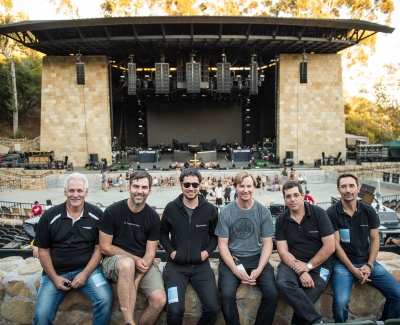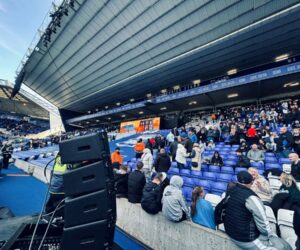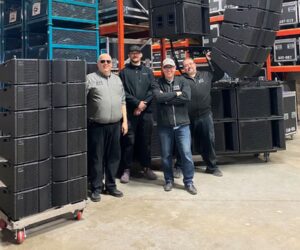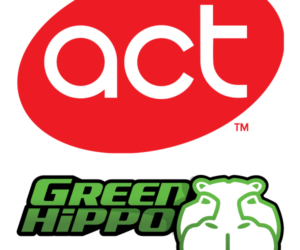2017 was, by all means, a banner year for ODESZA. The “chillwave” electronic duo of Harrison Mills and Clayton Knight – individually known as Catacombkid and BeachesBeaches – dropped its third full-length album, A Moment Apart, in September, then followed it up with a globetrotting tour that whisked the artists off to Australia, New Zealand, England, Europe and, finally, back to North America for a string of sold-out shows.
In November, that same 16-song album release also nabbed the group a pair of nominations for two of EDM’s most prized categories, Best Dance Recording and Best Dance/Electronic Album, at the 60th Grammy Awards, which will take place later this month at Madison Square Garden in New York City. But certainly one of ODESZA’s most unique accomplishments late last year was one that was truly a “first” in North America, as well as a worldwide first for any electronic, pop or rock act, and that was the use of a new L-Acoustics L-ISA Live immersive audio system for a concert performance.
Having sonically reinforced ODESZA at numerous festivals over the years, Milwaukee/Phoenix/Denver-based Clearwing Productions was selected as the production provider for the group’s fall tour, supplying sound, video, lighting, and lasers, along with other gear and support.
For most of those dates, the audio gear complement looked like a fairly conventional truck-pack of 24 K1, 32 K2 and 15 Kara enclosures, 16 K1-SB and 24 KS28 subs, and various other L-Acoustics loudspeaker systems and amplified controllers accompanied by two DiGiCo SD10 consoles, plus an S21 monitor desk for the tour’s opening acts.
Making The Introductions
For fans at the 4,500-seat Santa Barbara Bowl show in late October, a special treat was in store – one that was ultimately artist-driven.
“Given the size and layout of the Santa Barbara Bowl, we knew that it would be an ideal venue for L-ISA,” says David Brooks, L-Acoustics application engineer, touring liaison. “We introduced Goldenvoice production manager Dean Cohen to the technology and he quickly suggested that ODESZA might be a good potential candidate, so we reached out to Clearwing Productions, who was carrying a K1/K2 system with the artists, to see if they would have an interest.”

L-Acoustics invited ODESZA’s front of house engineer, Patrick Hutchinson, to the company’s North America headquarters in Westlake Village, CA, to hear the system and create a live mix in the studio with L-ISA applications engineer Carlos Mosquera.
“Patrick called ODESZA’s Clayton Knight from the studio to describe the immersive mix he was getting, and he was interested enough that he came to Westlake later that week,” Brooks adds. “Clayton was immediately onboard with the technology and what it could bring to their performance, ultimately taking the idea back to Harrison Mills – the other half of the duo – and the rest of the team, who came back saying ‘let’s go.’”
“Hearing our music played back in the L-ISA studio, it was immediately apparent that the system had a natural and multi-dimensional feel,” Knight states. “I knew right away that we had to try it on our tour. We’re always pushing to produce the best experience for our fans, and this technology lets us deliver our show the way it was intended to be heard. The show in Santa Barbara was incredible and we were proud to be part of L-ISA’s launch here in North America.”
Instead of flying the standard left/right main arrays, the L-ISA deployment for the Santa Barbara Bowl tour stop used a proprietary (patent-pending) frontal system comprising seven arrays: three hangs of eight K2 in the center flanked by two hangs of 12 Kara as the high-resolution “scene” system and two outer arrays of eight Kara as the “extension” system. The sonically overlapping scene system arrays matched the full width of the stage to help foster accurate localization and separation of sound sources, as well as for the tracking of performers, while the extension system expanded the audio coverage to the venue’s side walls, stretching the soundscape of the performing zone and providing true crowd envelopment.
Behind the center K2 arrays were two sub-arrays, each featuring six KS28 with the bottom enclosures rear-firing for cardioid mode, maximizing low and sub-low frequency consistency over the audience. Seven Kara spread out across the stage lip and two ARCS II enclosures positioned on either side of the stage rounded out the fill system, and all enclosures were powered and processed via a combined total of 27 LA8 and LA12X amplified controllers in conjunction with the L-ISA Processor and L-ISA Controller.



















